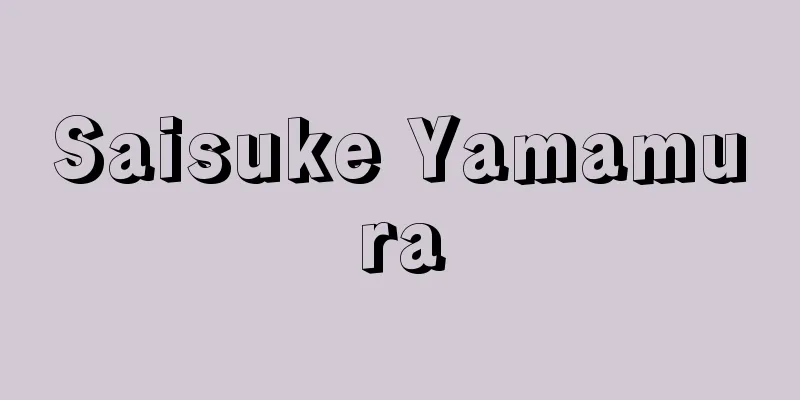Saisuke Yamamura

|
Year of death: Bunka 4.9.19 (1807.10.20) Year of birth: 1770 A Dutch scholar and world geographer of the late Edo period. His nickname was Saisuke, and his given name was Shoei. His pen name was Shimei, and his pen name was Yumeyu Dojin. He was the eldest son of Masashige, a retainer of the Tsuchiya clan, lord of Tsuchiura Castle in Hitachi Province (Ibaraki Prefecture). His mother Maki was the younger sister of Ichikawa Kansai. He was born in the Edo domain's residence. He studied Chinese classics under his uncle Ichikawa Kansai, and Dutch studies under Otsuki Gentaku. He is counted as one of the four great kings out of the 100 or so disciples of Gentaku, and was ranked as west sekiwake in the Dutch scholars' sumo rankings in 1798 (Kansei 10). With his excellent linguistic skills, he read Dutch geography and history books, and translated such works as "Touzai Kiyu", "Indian History", "Hyakuji Seiashi", "Ajia Shotoushi", and "Oonishi Yoroku". He also translated "Russiakokushi" by order of the shogunate. He also re-examined Chinese geography books written by Western missionaries active in China from the late Ming to the early Qing dynasty, using his knowledge of Dutch studies, and wrote works such as "Ming Confucian Translation of Bankoku Zusetsu Kosho" and "Corrected Illustrated Guide to the Forty-Two Countries." The latter was a criticism of "Forty-Two Countries Jinbutsu Zu" written by Nishikawa Nyomi, and he also severely criticized his peer Hashimoto Muneyoshi's world map in "Rokubenkou," but he showed his dedication as a wise man, such as by cooperating with his teacher Gentaku on "Kankai Ibun." His greatest achievement was the completion of "Corrected and Expanded Translation of Sairan Igen," in which he corrected Arai Hakuseki's world geography book and added new information from Dutch books, making it a work ten times larger than the original, and presented the book to the shogunate in Bunka 1 (1804). He died of illness at the age of 38. Because his works were not published during his lifetime, "Seiyo Zakki," written with excerpts from his translations, was published without his permission after his death, and plagiarized versions were published. He can be considered the founder of Western history studies in Japan, and his translations were copied and used by such late Edo intellectuals as Hirata Atsutane, Watanabe Kazan, and Yoshida Shoin to change their perceptions of foreign countries. (Hiroshi Ishiyama) Source: Asahi Japanese Historical Biography: Asahi Shimbun Publications Inc. About Asahi Japanese Historical Biography |
|
没年:文化4.9.19(1807.10.20) 生年:明和7(1770) 江戸後期の蘭学者,世界地理学者。才助は通称,名は昌永。字を子明,号を夢遊道人という。常陸国(茨城県)土浦城主土屋氏家臣昌茂の長男。母まきは市河寛斎の妹。江戸藩邸に生まれた。伯父市河寛斎に漢学を,大槻玄沢に蘭学を学ぶ。玄沢門弟百余名中の四天王のひとりに数えられ,寛政10(1798)年の蘭学者相撲番付に西関脇で載る。達者な語学力でオランダ語の地理・歴史書を読み,『東西紀游』『印度志』『百児西亜志』『亜細亜諸島誌』『大西要録』などを訳述した。幕命により訳した『魯西亜国志』もある。明末期から清初期の中国で活躍した西洋人宣教師の著した漢籍地理書も蘭学の知識と併せて再吟味し,『明儒翻訳万国図説考証』『訂正四十二国人物図説』などを著した。後者は西川如見著の『四十二国人物図』の批判であり,同輩橋本宗吉の世界図に対しても『六費弁誤』で厳しく批判したが,師玄沢には『環海異聞』への協力など,才助だからこその尽力がみえる。最大の業績は新井白石の世界地理書を訂正し,蘭書から新情報を挿入して原著の10倍の大著にした『訂正増訳采覧異言』の完成で,同書は文化1(1804)年幕府に献上された。38歳で病没。著作が生前公刊されなかったことから,訳稿の抜粋で綴った『西洋雑記』が死後に無断出版されたり,剽窃本が刊行された。日本の西洋史学の創始者とすることもでき,訳業は伝写されて平田篤胤,渡辺崋山,吉田松陰 など幕末知識人に海外への認識を改めさせる糧となった。<参考文献>鮎沢信太郎『山村才助』 (石山洋) 出典 朝日日本歴史人物事典:(株)朝日新聞出版朝日日本歴史人物事典について 情報 |
Recommend
Matisse
French painter. Born in Le Cateau-Cambrésis in nor...
Engineering - kougaku (English spelling) engineering
The word "engine" comes from the Latin ...
Saame
...In ancient documents, they are written as &quo...
Okugun
The entry for December 776 in the Shoku Nihongi (C...
"Kagamiyama" - Kagamiyama
…It is also written as “Kagamiyama Kyu-nishiki-e”...
Erigeron alpinus (English spelling) Erigeronalpinus
…[Hiroji Koyama]. . … *Some of the terminology th...
'ayyar (English spelling) ayyar
Of course, this Mamluk system was not without opp...
Euphorbiaceae
...All four of these species are poisonous plants...
Common Cause
...What is particularly conspicuous among these i...
Londinion
…It was once the center of the British Empire, an...
Revolutionary change of era
…The use of era names in Japan began in the Taika...
Hata Tokiyoshi
?-1341 A military commander from the Kamakura to ...
Bag bone - Taikotsu (English spelling) os marsupiale
The proximal ends of the hind limbs of mammals art...
Kanehiro Takagi
A naval doctor in the Meiji and Taisho periods. A...
Ahrland, SH (English spelling)
…These discoveries were followed by the discovery...









